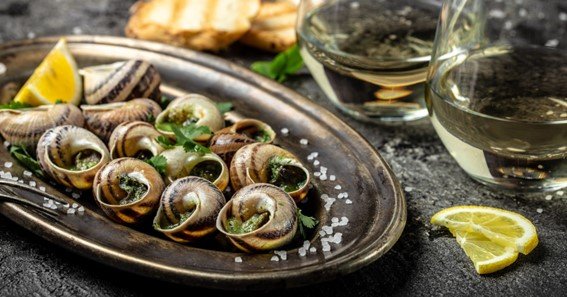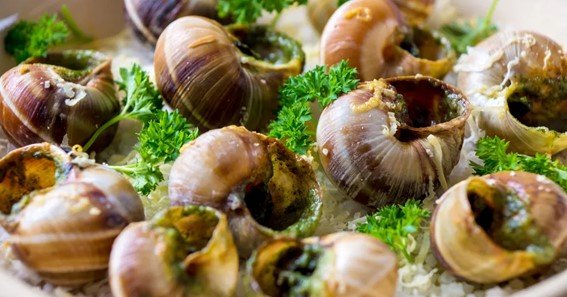What is Escargot? This French-inspired dessert is famous worldwide. In French, Escargot means snail. Escargots are appetizers made of sautéed land snails. Although Escargot may seem weird, foodies enjoy its delicate flavor and cultural significance. This article details what is Escargot, Escargot’s history, cuisine, culinary appeal, and common misconceptions.
What is Escargot?
Escargot is made from Helix pomatia and Helix aspersa land snails. Different countries cook and serve it differently. Snails are captured, cleaned, and cooked. They are typically served with butter and garlic sauce, not shells. Herbs and spices enhance the snail’s mild, earthy flavor in this recipe. Escargot, generally an appetizer, shows how inventive cooks can be with uncommon ingredients in sophisticated dishes.
Escargot preparation requires practice. Before cooking snails, their stomach juices are removed to preserve flavor. Garlic, butter, parsley, and white wine make a delicious snail sauce. Escargot is popular worldwide and tastes great in French restaurants and gastro pubs. That is a brief information on what is Escargot.
Cultural Significance of Escargot

Since you know a bit about what is Escargot, Escargot tastes good and is culturally significant in French and Mediterranean cuisines. It has long been liked in France since it is healthy and increases sexual interest.
It was eaten throughout Europe throughout the Roman Empire and is now considered high-class. Escargot is served in restaurants worldwide as a tribute to French cuisine and to demonstrate its versatility in modern meals.
Escargot is culturally significant beyond its taste. Family reunions and small French bistros with history and customs come to mind. Escargot is offered at weddings and other critical ceremonies in Mediterranean countries to celebrate prosperity and luck.
Escargot is now eaten slowly and deliberately to promote leisurely meals and appreciation for life’s basic pleasures. Escargot symbolizes French food and unites cultures and cuisines worldwide.
Preparation Methods for Escargot
Escargot is made with numerous painstaking procedures to taste and feel perfect. After harvesting, snails are cleaned to remove dirt and bacteria. Traditional snail cooking involves boiling them in seasoned broth or water and then shelling them.
The snail meat is blended with delectable butter, garlic, parsley, and sometimes wine or brandy sauce. This mixture gives the snails the rich, aromatic taste of Escargot. Modern dishes may incorporate herbs or spices, adding new meanings while remaining loyal to their heritage.
To make outstanding Escargot, pay attention to details and use high-quality ingredients. Fresh parsley, garlic, butter, and wine are essential. Some recipes require shallots or mushrooms for flavor. Snails should be cooked until tender but firm. Chefs and home cooks may showcase French cuisine by mastering these Escargot preparations.
Health Benefits of Escargot
Escargot is often considered harmful. However, it has several health benefits. Escargot contributes iron, calcium, vitamins (especially B12), and protein to health. It’s healthier than standard diets because it’s low in fat and cholesterol. Escargot can be healthy if appropriately prepared. It contains healthy nutrients.
These snails help people obtain more protein. Escargot contains minerals and vitamins that support red blood cell production, brain function, and bone health. It’s helpful for dieters and heart patients because it has less fat. Escargot, a neglected delicacy, makes a delightful and healthy lunch.
Misconceptions about Escargot

Escargot is a popular meal, but myths prevent people from tasting it. People worry about texture, taste, and morality when snails are gathered. They assume Escargot is slimy or hard to chew because it’s overcooked.
When cooked well, Escargot is soft and juicy, which finicky diners love. Eliminating these myths about Escargot showcases its culinary potential and encourages adventurous eaters to try new things.
Escargot is hard to cook and requires particular tools and abilities. However, anyone can cook excellent Escargot at home with everyday ingredients. Escargot is more than just eaten at posh restaurants or special events. Escargot can be served at casual gatherings or upscale establishments. Clearing out these fallacies lets foodies enjoy Escargot’s rich flavors and versatile uses.
Serving and Enjoying Escargot
Serving Escargot involves making it more appetizing and exciting to eat. Escargot is traditionally served in shells or plates. Each snail is in its buttery sauce and ready to be eaten with a special fork or pick. Bread, such as brioche or loaf, soaks up the sauce and enhances the dish. Escargot and fresh white wine or champagne make a delightful supper.
Escargot tastes better in a decent restaurant with good music. Soft music and dim lighting frequently create an elegant and relaxing ambiance. Dining with others makes Escargot more delightful since it stimulates conversation. Escargot must be eaten slowly and methodically to be enjoyable and plentiful, whether at a fancy restaurant or home with friends.
Conclusion
In summary, what is Escargot? Escargot is more than a tasty food—it symbolizes centuries of culinary heritage, cultural significance, and culinary expertise. Escargot has fascinated foodies worldwide, from its humble beginnings to its elevated standing on modern plates.
Knowing how it’s manufactured, its health advantages and its culture enhances your enjoyment of this pleasure. Escargot combines classic and contemporary cuisine and is lovely. It can be eaten as a beginning or to learn about another culture.
Escargot has many tastes, textures, and stories as we discover more. Everything about Escargot is made with care, from the snail’s sluggish movement to the chef’s talent. Escargot makes you slow down, enjoy, and appreciate great cooking, whether you’re a chef or just interested in food. Join me on this culinary adventure to discover Escargot’s greatness. That’s all on what is Escargot.
FAQ
Can Escargot be eaten raw?
Escargot is unsafe to eat uncooked due to parasites and bacteria. Cooking snails properly makes them safe to eat.
What is the taste of Escargot?
Escargot’s flavor is mild and earthy, like clams or mussels. It tastes excellent with butter and garlic sauce.
Can I eat something vegetable instead of Escargot?
Some restaurants serve mushroom or plant-based Escargot. These meals taste and look like Escargot.
Is Escargot healthy?
Sustainable Escargot harvesting emphasizes responsible sources and ecological balance. Choose certified sustainable products to protect the environment.
Is freezing Escargot ok?
Cooked Escargot can be reused. The best technique to store frozen Escargot is to preserve its quality and flavor, making it easy to cook.
Sources:
https://www.britannica.com/animal/Escargot
https://www.offbeatfrance.com/snails-in-france-Escargots.html










